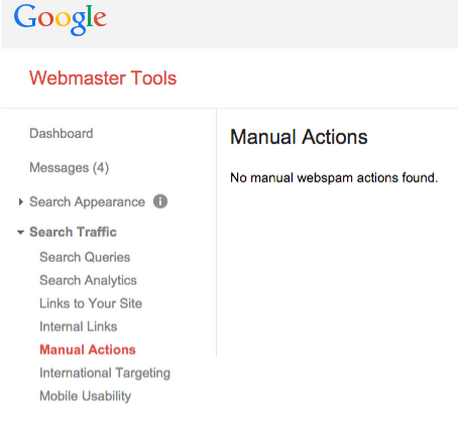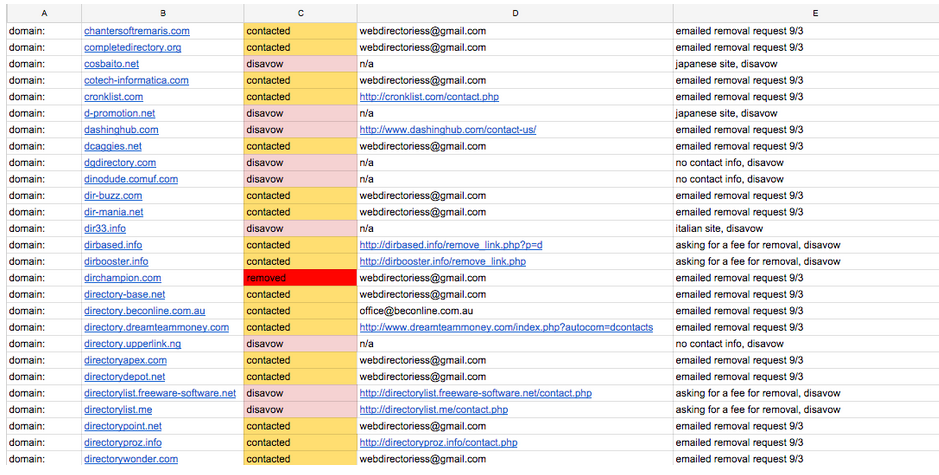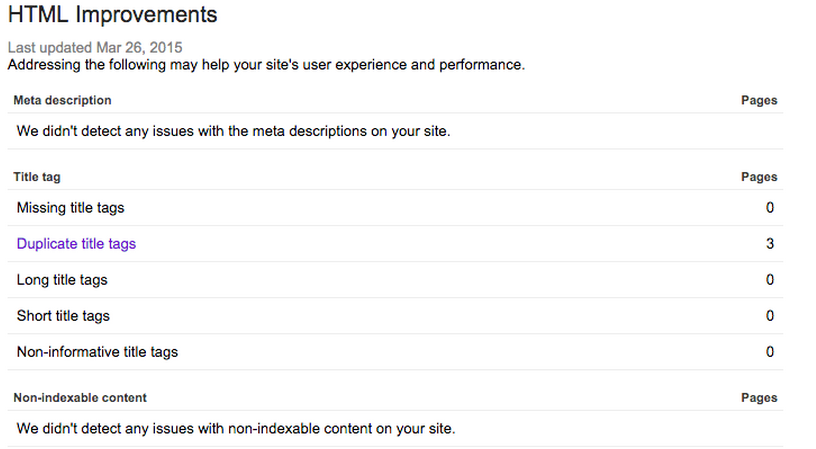Experiencing a large drop in rankings can be confusing and frustrating. It could also mean a significant loss in leads or profits for your website. If you don’t have the know-how or the means to fix the issue quickly, the future of your company’s income could be in danger.
The first step in recovering from a large drop in rankings is identifying what type of penalty you have. Depending on the type of penalty there will be a very different set of steps you need to take towards regaining your traffic and rankings.
You can generally group penalties into one of two categories, manual or algorithmic:
Manual Action
A manual penalty (Google refers to it as a “manual action”) refers to instances where Google’s web spam team has manually flagged your site as being in direct violation of Google’s guidelines and has either demoted your site in the rankings or banned your website all together.
A manual action is easy to identify because Google will send you a notification through Webmaster Tools. Once you claim your website on Webmaster Tools, navigate to the “Search Traffic” drop down and click on “Manual Actions.” Here, Google will tell you specifically what type of penalty you have.

Causes of manual penalties include:
Unnatural links (this is probably the most common cause of manual actions) Thin content Hacked website Pure spam or user-generated spam Cloaking or sneaky redirects Hidden text or keyword stuffing Spammy structured markupsManual actions can either be partial (only applied to certain pages of your website) or site-wide (applied to your entire domain).
For a full list of manual actions with detailed descriptions of each, visit Google’s support page.
Algorithmic Penalty
An algorithmic penalty is technically not a penalty. Instead, it's a change to Google’s algorithm that negatively affects your website’s rankings. These “penalties” can result in minor drops in rankings to massive organic losses where your website gets demoted several pages in the SERPs (search engine results pages). These penalties are significantly harder to identify because there will not be a notification from Google.
Oftentimes, algorithmic penalties will be related to one of the major Google algorithms: Panda or Penguin.
Fixing A Manual Action Penalty
Since Google will tell you exactly what kind of manual penalty you have, fixing the problem should be pretty straightforward and involves 2 major steps:
1. Fix the issue on your website
Most fixes for manual action penalties will be pretty obvious:
Manual Action: Unnatural links
How To Fix It: Audit and clean up your incoming links, ask spammy sites to remove links to you, and submit a disavow of links that couldn’t be removed.
Manual Action: Thin content
How To Fix It: Add more relevant content to your website and improve site UX.
Manual Action: Hacked website
How To Fix It: Remove the hacked pages or portion of your site.
Manual Action: Pure spam or user-generated spam
How To Fix It: Remove spammy content, replace with content that is good for users.
Manual Action: Cloaking or sneaky redirects
How To Fix It: Use the “Fetch as Google” tool in Webmaster Tools to make sure users and Google's bot are being served the same content, or remove bad redirects that could be judged as unnecessary or manipulative.
Manual Action: Hidden text or keyword stuffing
How To Fix It: Check your pages source code and CSS to make sure you aren’t hiding keywords or content and remove meta keywords if you are abusing them. Rewrite keyword-stuffed content with the user in mind, not for ranking manipulation.
Manual Action: Spammy Structured Markup
How To Fix It: Make sure your markups are within Google’s rich snippet guidelines and remove any misleading or hidden markups. Use Google’s rich snippet testing tool to check all of your markups.
2. Submit a Reconsideration Request
Once you have cleaned up the issues that landed you a manual penalty, you need to submit a reconsideration request to Google’s web spam team. This will let them know you are now in compliance with Google guidelines and that you believe the penalty should be lifted. There is no right or wrong way to write a reconsideration request, but there are several things you can do to help your chances of getting your penalty lifted:
Be Honest: If the penalty was caused by mistakes that you had made in the past, own up to your mistakes. If the problems we’re created by an old SEO company or employee, tell this to Google. Document Your Work: Be meticulous in documenting the work you are doing to fix the problem. Create a Google doc to show all of the steps you are taking to clean up your website, then link to this document in your reconsideration request so Google can see all of your efforts. Demonstrate Your Knowledge and Understanding: Tell Google that you understand why you received the manual action and that you will work to ensure your website doesn’t violate any web spam rules in the future. Be Transparent: Sign your name to your reconsideration request and include your contact info. Using your full name and contact info is much more trusted than submitting your request anonymously.Once you have finished writing your reconsideration request, go to the Manual Actions section of Webmaster Tools and click “Request a review” to submit it. Within a few weeks you should get a notification email telling you whether your manual action has been lifted or that you need to do more work to fix the problem.
It is not uncommon that your first reconsideration request is rejected if you didn’t show Google that you have done your best to fix the problem, so take your time and do your best to fix your website before submitting your request. If your first reconsideration request gets rejected, you are able to submit again. However, take the time to do a thorough job the first time so the process doesn’t get dragged out.
Fixing An Algorithmic Penalty
Since algorithmic penalties don’t come with a direct notification from Google, they tend to be much harder to identify and fix. Finding the problem with your website will require some heavy detective work so you may be best off hiring an SEO professional to help you.
Most algorithmic penalties stem from issues with two algorithms. One is the Google Penguin algorithm, which penalizes websites for spammy or manipulative link profiles. The other is Google Panda, which penalizes websites with thin, duplicate or spammy content.
To narrow down what is causing your issues, you will want to reference a list of major algorithm changes. This will let you see possible correlations of your loss of traffic with specific algorithm updates. Moz undoubtedly offers the most comprehensive list of algorithm changes with dates and explanations of each update.
Start by looking at your website stats in Google Analytics or in Semrush to see the date that you lost your traffic. This Semrush screenshot is from a client that came to us looking for help recovering his traffic after losing almost 100% of his organic visibility in October of 2013.

When we cross reference the October 2013 loss of traffic against the Moz algorithm update list we see that there is a good chance this client was hit by the Penguin 2.1 update that rolled out on October 4th, 2013. With this information in mind, we ran a Link Research Tools DTOX report and uncovered tens of thousands of spammy links that an old SEO company had built. In order to help this client recover we now knew we would need to start the process of cleaning up his link profile.
Fixing a Penguin Algorithm Penalty
Once you find that your ranking issues are related to Google Penguin, you will need to start the process of cleaning up your link profile. Since the Google Penguin algorithm punishes websites with spammy link profiles, you will need to remove the bad links pointing towards your website. In order to do the most thorough job possible, I suggest gathering link data from as many sources as you can, such as Ahrefs, Webmaster Tools, and Link Research Tools, then combine all of your links into one spreadsheet.
Here is a screenshot from a cleanup we did for a client:

As you sort through the list of bad links that you’ve found, keep track of the domain, when you contacted the webmaster asking them to remove the link, the contact info for the webmaster, and the date of contact.
Typically, I will email the website that contains a bad link and politely ask them to take it down. After contacting them twice with no removal or response, I will add the domain to a disavow list. Once you’ve manually removed as many toxic links as possible through reaching out to webmasters, you should submit the remaining links to Google in the form of a disavow file.
A disavow file is a list of domains or URLs that tells Google that you don’t want these links to affect your rankings. Remember, disavows are very serious, and if done wrong could harm your rankings. Be careful and consult with a professional if you are unsure of what to do.
Penguin Recovery Doesn’t Happen Over Night
Once you’ve cleaned up your link profile and submitted a disavow file, you will have to be patient and wait for Google to re-crawl your links. I’ve seen Penguin recoveries take anywhere from a few weeks to over a year. It took around 15 months before the website regained the full traffic that it had before the algorithmic penalty.
On Page / Google Panda Audit
If you have a clean backlink profile and you think your ranking troubles are related to Panda or on-page optimization rather than Penguin, you will need to do an extensive audit of your website to find any potential issues. You will need to do a manual review of your site to look for any pages of content that could be construed as spammy or thin. Things to look for in doing a manual website audit include:
Plagiarized content Thin content Duplicate content that appears on multiple pages Badly crafted header tags (multiple h1s on a page) Duplicate page titles across multiple pages Duplicate meta descriptions Excess or unnecessary HTML or CSS in your code Spammy or over-optimized URL slugs Poorly built website or theme that doesn’t easily allow Google bots to crawl your site Robots.txt file that is blocking crucial website resources Extra pages that are indexed but not findable to users through navigation Too many ads (especially above the fold)There are also many tools across the web that will audit your website to find potential issues that you may have missed; one of the most reliable of which is Google itself. Within Webmaster Tools, there is a section called “HTML Improvements” that will show you potential issues with your site. In this example, I found that 3 pages on this site have duplicate title tags, which need to be updated:

Since there are so many on-page factors that could trigger a Panda issue on a website, you will need to be thorough and patient during the recovery process. Run as many audits as you can to identify potential problems and make sure you thoroughly understand the Google guidelines as you fix your site.
Conclusion
Unfortunately, there is no easy way to identify or fix a Google penalty. Getting back into good grace with Google is time consuming and often frustrating, but with hard work you should be able to get back to where you were before the penalty hit. As SEO professionals, we have to constantly stay on top of new advances in the industry and the algorithms (see the upcoming mobile algorithm update, for example) so that we can avoid major rankings issues in the future.
Whether your penalty is manual or algorithmic, Penguin or Panda, with persistence and a little bit of patience, you can get back on top. Xamalicious malware
Innovative SEO services
SEO is a patience game; no secret there. We`ll work with you to develop a Search strategy focused on producing increased traffic rankings in as early as 3-months.
A proven Allinclusive. SEO services for measuring, executing, and optimizing for Search Engine success. We say what we do and do what we say.
Our company as Semrush Agency Partner has designed a search engine optimization service that is both ethical and result-driven. We use the latest tools, strategies, and trends to help you move up in the search engines for the right keywords to get noticed by the right audience.
Today, you can schedule a Discovery call with us about your company needs.
Source:




![How To Create a Strategic Dashboard in Excel Using Semrush Data [Excel Template Included]](https://allinclusive.agency/uploads/images/how-to-create-a-strategic-dashboard-in-excel-using-semrush-data-excel-template-included.svg)
